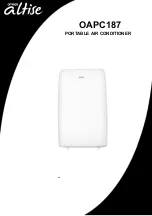
5
- 17
5
Test Run and Others
2. Test Run
Possible cause of malfunction
Remote controller is detecting
error signal from indoor unit.
Indoor unit is detecting error
signal from outdoor unit.
Improper setting of indoor unit or
remote controller.
During auto. address setting,
number of connected units does
not correspond to number set.
When turning on the power
supply, number of connected
units does not correspond to
number set.
(Except R.C. address is “0.”)
Indoor unit communication error
of group control wiring.
Alarm
message
<E01>
<E02>
<E06>
<<E03>>
E04
E08
<<E09>>
E12
E15
E16
E20
E25
E18
Indoor unit is detecting error signal from remote controller (and system controller).
Error in receiving serial communication signal.
(Signal from main indoor unit in case of group control)
Ex: Auto address is not completed.
Error in transmitting serial communication signal.
Error in receiving serial communication signal.
When turning on the power supply, the number of connected
indoor units does not correspond to the number set. (Except R.C.
address is “0.”)
Indoor unit address setting is duplicated.
Remote controller address connector (RCU. ADR) is duplicated.
(Duplication of main remote controller)
Starting auto. address setting is prohibited.
Error in auto. address setting. (Number of connected indoor units
is less than the number set)
Error in auto. address setting. (Number of connected indoor units
is more than the number set)
Error of outdoor unit address setting.
Error of main indoor unit in receiving serial communication signal
from sub indoor units.
Error of the outdoor unit in receiving serial communication signal
from the indoor unit.
This alarm message shows that the auto address connector CN100
is shorted while other RC line is executing auto address operation.
No indoor unit is connected during auto. address setting.
Serial commu-
nication errors
Mis-setting
Continued
LED 1
LED 2
Alarm contents
Alternating
Alarm display
LED 1 blinks M times, then LED 2 blinks N times. The cycle then repeats.
M = 2: P alarm 3: H alarm 4: E alarm 5: F alarm 6: L alarm
N = Alarm No.
Example: LED 1 blinks 2 times, then LED 2 blinks 17 times. The cycle then repeats.
Alarm is “P17.”
( : Blinking)
CAUTION
G
This outdoor unit cannot collect more than the rated refrigerant amount as shown
by the nameplate on the back.
G
If the amount of refrigerant is more than that recommended, do not conduct pump
down. In this case use another refrigerant collecting system.
2-5. Caution for Pump Down
Pump down means refrigerant gas in the system is
returned to the outdoor unit. Pump down is used
when the unit is to be moved, or before servicing the
refrigerant circuit.
2-6. Meaning of Alarm Messages
Table of Self-Diagnostics Functions and Description of Alarm Displays
Alarm messages are indicated by the blinking of LED 1 and 2 (D72, D75) on the outdoor unit PCB. They are also displayed on
the wired remote controller.
G
Viewing the LED 1 and 2 (D72 and D75) alarm displays
06-405 Mini-ECOi_TD5 11/6/06 5:01 PM Page 17
Содержание SPW-CR365GX56
Страница 5: ...1 1 1 Outline of Mini ECO i SYSTEM Contents 1 OUTLINE OF MINI ECO i SYSTEM 1 Line up 1 2 ...
Страница 8: ...1 4 MEMO ...
Страница 322: ...4 180 MEMO ...
Страница 330: ...CN33 S003 CN51 CN50 D043 LED2 D042 LED1 S002 S004 5 8 Test Run and Others 2 Test Run Fig 5 10 2 for SPW CR GX H 8 5 ...
Страница 344: ...5 22 MEMO ...
Страница 345: ...200611M DC ...







































